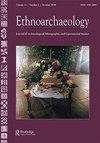当代博茨瓦纳东南部的烧制锅
IF 1.3
0 ARCHAEOLOGY
引用次数: 1
摘要
多年来,南部非洲的考古学家一直将陶器“风格”与考古“文化”和现代民族语言群体等同起来。为了调查这种联系,我们对博茨瓦纳东南部的41名当代陶工进行了一项民族考古学研究,以观察陶工的社会群体与他们对特定风格的制作和装饰陶器的偏好之间的关系。本文介绍和分析了当代博茨瓦纳东南部陶器制造的烧制阶段,并寻找对烧制技术偏好的社会界限。与半个世纪前完成的一项研究不同,我们发现,烧制技术的偏好是基于村庄的,反映了当地陶工使用的共同技术,而不考虑他们的语言归属、民族成员、性别、年龄、宗教信仰或他们学习工艺的网络。本文章由计算机程序翻译,如有差异,请以英文原文为准。
Firing Pots in Contemporary South-Eastern Botswana
ABSTRACT For many years, archaeologists in Southern Africa have equated pottery “style” with archaeological “cultures” and modern ethno-linguistic groups. In order to investigate this association, we undertook an ethnoarchaeological study of 41 contemporary potters in south-eastern Botswana to observe what social groupings of potters correlate with their preferences for a particular style of making and decorating pots. This paper presents and analyses the firing stage of pottery manufacturing in contemporary south-eastern Botswana and looks for social boundaries in the preference for firing techniques. Unlike a study completed half a century ago, we find that firing technique preferences are village based and reflect the common technique used by potters in that locality, regardless of their linguistic affiliation, ethnic group membership, gender, age, religious persuasion or the network in which they learnt their craft.
求助全文
通过发布文献求助,成功后即可免费获取论文全文。
去求助
来源期刊

Ethnoarchaeology
ARCHAEOLOGY-
CiteScore
1.60
自引率
0.00%
发文量
10
期刊介绍:
Ethnoarchaeology, a cross-cultural peer-reviewed journal, focuses on the present position, impact of, and future prospects of ethnoarchaeological and experimental studies approaches to anthropological research. The primary goal of this journal is to provide practitioners with an intellectual platform to showcase and appraise current research and theoretical and methodological directions for the 21st century. Although there has been an exponential increase in ethnoarchaeological and experimental research in the past thirty years, there is little that unifies or defines our subdiscipline. Ethnoarchaeology addresses this need, exploring what distinguishes ethnoarchaeological and experimental approaches, what methods connect practitioners, and what unique suite of research attributes we contribute to the better understanding of the human condition. In addition to research articles, the journal publishes book and other media reviews, periodic theme issues, and position statements by noted scholars.
 求助内容:
求助内容: 应助结果提醒方式:
应助结果提醒方式:


